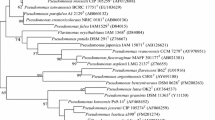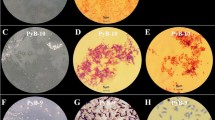Abstract
Polycyclic aromatic hydrocarbons (PAHs) are a class of persistent organic compounds derived from natural sources and anthropogenic processes, which have been recommended as priority pollutants. Degradation of PAHs in the environment is becoming more necessary and urgent. In the current study, strain PL2, which is capable of growing aerobically on pyrene (PYR) as the sole carbon source, was isolated from hydrocarbons-contaminated soil and then identified as Pseudomonas putida by morphological and physiological characteristics as well as 16S rDNA sequence. The strain PL2 was able to degrade 50.0% of the pyrene at 28°C within 6 days in the presence of 50 mg/L pyrene, while the strain PL2 degraded 50.0% of the pyrene within 2 days when a solution of 50 mg/L pyrene and 50 mg/L phenanthrene was used. In addition, phenanthrene was shown to increase the biodegradation efficiency of pyrene by the strain PL2. The order of degradation by the strain PL2 was pH 6.0 > pH 7.0 > pH 5.0 > pH 8.0. The degradation rate of PYR in the soil by the strain PL2 reached 70.0% at the 10th day. The dynamics of PYR degradation in soil by PL2 was fit to the first order model and the strain PL2 was shown to efficiently degrade PYR in soil. The current study showed that P. putida PL2 was a novel bacterium that could degrade pyrene and holds great promise for use in PAHs bioremediation in soil.
Similar content being viewed by others
References
Fetzer, J. C. (2007) The chemistry and analysis of large PAHs. Polycycl Aromat. Comp. 27: 143–162.
Wilson, S. C. and K. C. Jones (1993) Bioremediation of soil contaminated with polynuclear aromatic hydrocarbons: A review. Environ. Pollut. 81: 229–249.
Carmichael, L. M., R. F. Christman, and F. K. Pfaender (1996) Desorption and mineralization kinetics of phenanthrene and chrysene in contaminated soil. Environ. Sci. Technol. 31: 126–132.
Blumer, M. (1961) Benzopyrenes in soils. Sci. 134: 474–475.
Maliszewska-Kordybach, B. (1996) Polycyclic aromatic hydrocarbons in agricultural soils in Poland: preliminary proposals for criteria to evaluate the level of soil contamination. Appl. Geochem. 11: 121–127.
Wang, X. L., S. Tao, R. W. Dawson, and X. J. Wang (2004) Uncertainty analysis of parameters for modeling the transfer and fate of benzo (a) pyrene in Tianjin wastewater irrigated areas. Chemosphere 55: 525–531.
Chung, M. K., R. Hu, K. C. Cheung, and M. H. Wang (2007) Pollutants in Hong Kong soils: Polycyclic aromatic hydrocarbons. Chemosphere 67: 464–473.
Motelay-Massei, A., D. Ollivon, B. Garban, M. J. Teil, M. Blanchard, and M. Chevreuil (2004) Distribution and spatial trends of PAHs and PCBs in soils in the Seine River basin, France. Chemosphere 55: 555–565.
Kastner, M. and B. Mahro (1996) Microbial degradation of polycyclic aromatic hydrocarbons in soil affected by the organic matrix of compost. Appl. Microbiol. Biot. 44: 668–675.
Mahmood, S. K. and P. R. Rao (1993) Microbial abundance and degradation of polycyclic aromatic hydrocarbons in soil. B. Environ. Contam. Tox. 50: 486–491.
Li, X. J., X. Lin, P. J. Li, W. Liu, L. Wang, F. Ma, and K. S. Chukwukae (2009) Biodegradation of the low concentration of polycyclic aromatic hydrocarbons in soil by microbial consortium during incubation. J. Hazard. Mater. 172: 601–605.
Yuan, S. Y., S. H. Wei, and B. V. Chang (2000) Biodegradation of polycyclic aromatic hydrocarbons by a mixed culture. Chemosphere 41: 1463–1468.
Gibson, D. T., V. Mahadevan, R. M. Jerina, H. Yogi, and H. J. Yeh (1975) Oxidation of the carcinogens benzo[a] pyrene and dibenz[a,h] anthracene to dihydrodiols by a bacterium. Sci. 189: 295–297.
Johnson, A. R., L. Y. Wick, and H. Harms (2005) Principles of microbial PAH-degradation in soil. Environ. Pollut. 133: 71–84.
Tiwari, J. N., M. M. K. Reddy, D. K. Patel, S. K. Jain, R. C. Murthy, and N. Manickam (2010) Isolation of pyrene degrading Achromobacter xylooxidans and characterization of metabolic product. World J. Microb. Biot. 26: 1727–1733.
Wang, D. G., M. Yang, H. L. Jia, L. Zhou, and Y. F. Li (2009) Polycyclic aromatic hydrocarbons in urban street dust and surface soil: Comparisons of concentration, profile, and source. Arch. Environ. Con. Tox. 56:173–180.
Chen, L. G., Y. Ran, B. S. Xing, and B. X. Mai (2005) Contents and sources of polycyclic aromatic hydrocarbons and organochlorine pesticides in vegetable soils of Guangzhou, China. Chemosphere 60: 879–890.
Wang, C. G., F. Wang, T. Wang, Y. G. Bian, X. L. Yang, and X. Jiang (2010) PAHs biodegradation potential of indigenous consortia from agricultural soil and contaminated soil in two-liquidphase bioreactor (TLPB). J. Hazard. Mater. 176: 41–47.
Rehmann, K., H. P. Noll, C. E. Steinberg, and A. A. Kettrup (1998) Pyrene degradation by Mycobacterium sp. strain KR2. Chemosphere 36: 2977–2992.
John, G. H. and N. R. Krieg (1994) Bergey’s manual of determinative bacteriology. (9th eds.). Baltimore-Philadelphia-Hongkong-London-Munich-Sydney-Tokyo, Williams & Wilkins.
Frederich, M. A., B. Roger, E. K. Robert, D. M. David, J. G. Seidman, A. S. John, and S. Kevin (1999) Short protocols in molecular biology. pp. 2–12. John Wiley & Sons.
Cui, F. J., Z. Q. Liu, L. Yin, L. F. Ping, L. Y. Ping, Z. C. Zhang, L. Lin, Y. Dong, and D. Huang (2010) Production of mycelial biomass and exo-polymer by Hericiumerinaceus CZ-2: Optimization of Nutrients levels using response surface methodology. Biotechnol. Bioproc. E. 15: 299–307.
Liu, Z. Q., L. Z. Jia, and Y. G. Zheng (2010) Biotransformation of D L-lactate to pyruvate by a newly isolated Serratia marcescens ZJB-07166. Proc. Biochem. 45: 1632–1637.
Chung, C. T., S. L. Niemela, and R. H. Miller (1989) One-step preparation of competent Escherichia coli: Transformation and storage of bacterial cells in the same solution. Proc. Natl. Acad. Sci. USA. 86: 2172–2175.
Ping, L. F., Y. M. Luo, L. H. Wu, W. Qian, J. Song, and P. Christie (2006) Phenanthrene adsorption by soils treated with humic substances under different pH and temperature conditions. Environ. Geochem. Hlth. 28: 189–195.
Ping, L. F., Y. M. Luo, C. B. Zhang, Q. B. Li, and L. H. Wu (2007) Distribution of polycyclic aromatic hydrocarbons in thirty typical soil profiles in the Yangtze River Delta region, east China. Environ. Pollut. 147: 358–365.
Boldrin, B., A. Tiehm, and C. Fritzche (1993) Degradation of phenanthrene, fluorene, fluoranthene, and pyrene by a Mycobacterium sp. Appl. Environ. Microbiol. 59: 1927–1930.
Tao, X. Q., G. N. Lu, Z. Dang, Y. Chen, and Y. Y. Xiao (2007) A phenanthrene-degrading strain Sphingomonas sp. GY2B isolated from contaminated soils. Proc. Biochem. 42: 401–408.
Ma, J., H. P. Gao, L. Y. Jia, L. Xu, and J. Xie (2008) Isolation and characterization of PAHs degrading bacteria from activated sludge. J. Biotechnol. 136: S697–S698.
Sheng, X. F., X. B. Chen, and L. Y. He (2008) Characteristics of an endophytic pyrene-degrading bacterium of Enterobacter sp. 12J1 from Allium macrostemon Bunge. Int. Biodeter. Biodegr. 62: 88–95.
Zhang, G. Y., J. Y. Ling, H. B. Sun, J. Luo, Y. Y. Fan, and Z. J. Cui (2009) Isolation and characterization of a newly isolated polycyclic aromatic hydrocarbons-degrading Janibacter anophelis strain JY11. J. Hazard. Mater. 172: 580–586.
Klankeo, P., W. Nopcharoenkul, and O. Pinyakong (2009) Two novel pyrene-degrading Diaphorobacter sp. and Pseudoxanthomonas sp. isolated from soil. J. Biosci. Bioeng. 108: 488–495.
Guo, C. L., Z. Dang, Y. S. Wong, and N. F. Tam (2010) Biodegradation ability and dioxgenase genes of PAH-degrading Sphingomonas and Mycobacterium strains isolated from mangrove sediments. Int. Biodeter. Biodegr. 64: 419–426.
Mihelcic, J. R. and R. G. Luthy (1993) Bioavailability of sorbed- and separate-phase chemicals. Biodegradation. 4: 141–153.
Woo, S. H., M. W. Lee, and J. M. Park (2004) Biodegradation of phenanthrene in soil-slurry systems with different mass transfer regime and soil content. J. Biotechnol. 110: 235–250.
Su, D., P. J. Li, X. Wang, and H. X. Xu (2007) Degradation and kinetics of pyrene and benzo[a] pyrene by three bacteria in contaminated soil. Environ. Sci. 28: 913–917.
Jimenez, I. and R. Bartha (1996) Solvent-augmented mineralization of pyrene by a Mycobacterium sp. Appl. Environ. Microb. 62: 2311–2316.
Kastner, M., M. Breuer-Jammali, and B. Mahro (1998) Impact of inoculation protocols, salinity, and pH on the degradation of polycyclic aromatic hydrocarbons (PAHs) and survival of PAH-degrading bacteria introduced into soil. Appl. Environ. Microb. 64: 359–362.
Cerniglia, C. E. (1992) Biodegradation of polycyclic aromatic hydrocarbons. Biodegradation. 3: 351–368.
Haritash, A. K. and C. P. Kaushik (2009) Biodegradation aspects of polycyclic aromatic hydrocarbons (PAHs): A review. J. Hazard. Mater. 169: 1–15.
Zeng, J., X. G. Lin, J. Zhang, and X. G. Li (2010) Isolation of polycyclic aromatic hydrocarbons (PAHs)-degrading Mycobacterium sp. and the degradation in soil. J. Hazard. Mater. 183: 718–723.
El-Mansi, E. M. T., C. F. A. Bryce, A. L. Demain, and A. R. Allman (2007) Fermentation microbiology and biotechnology (2nd ed). CRC press.
Su, D., P. J. Li, and J. L. Ju (2006) Degradation of pyrene and benzo[a]pyrene in soil by six strains of fungi and its kinetics. China Environ. Sci. 26: 188–191.
Anastasi, A., T. Coppola, V. Prigione, and G. C. Varese (2009) Pyrene degradation and detoxification in soil by a consortium of basidiomycetes isolated from compost: Role of laccases and peroxidases. J. Hazard. Mater. 165: 1229–1233.
Romero, M. C., M. L. Salvioli, M. C. Cazau, and A. M. Arambarri (2002) Pyrene degradation by yeasts and filamentous fungi. Environ. Pollut. 117: 159–163.
Ramirez, N., T. Cutright, and L. K. Ju (2001) Pyrene biodegradatin in aqueous solutions and soil slurries by Mycobacterium PYR-1 and enriched consortium. Chemosphere 44: 1079–1086.
Author information
Authors and Affiliations
Corresponding authors
Rights and permissions
About this article
Cite this article
Ping, L., Zhang, C., Zhu, Y. et al. Biodegrading of pyrene by a newly isolated Pseudomonas putida PL2. Biotechnol Bioproc E 16, 1000–1008 (2011). https://doi.org/10.1007/s12257-010-0435-y
Received:
Revised:
Accepted:
Published:
Issue Date:
DOI: https://doi.org/10.1007/s12257-010-0435-y




